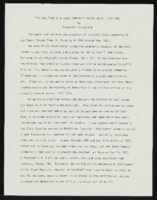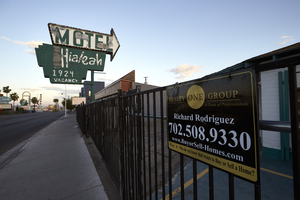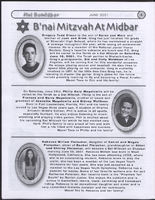Search the Special Collections and Archives Portal
Search Results
Maurine and Fred Wilson and William S. Park Audiovisual Collection
Identifier
Abstract
The Maurine and Fred Wilson and Dr. William S. Park Audiovisual Collection (approximately 1900s-1970s) consist of audiovisual material created by the Wilson and Park families. The materials depict the Park homes in Las Vegas, Nevada; Park and Wilson family members; outdoor activities and vacation trips to California, Colorado, and Mexico. The collection also documents early views of the Kiel Ranch in Las Vegas, Nevada, community parades and events, and early views of Las Vegas in the 1920s.
Archival Collection

Transcript of interview with Pauleen Foutz by Don Scott Kaye, February 25, 1980
Date
Archival Collection
Description
Text

Lauren M. Brown oral history interview: transcript
Date
Archival Collection
Description
Oral history interview with Lauren M. Brown conducted by Claytee D. White on February 21, 2018 for the Remembering 1 October Oral History Project. In this interview, Lauren M. Brown discusses her history with Las Vegas, Nevada, starting from when she moved to the city in 1997. She describes her experience as one of the many who stood in line to donate blood on October 2, 2017, the day after the 2017 Las Vegas mass shooting. Brown talks about what stood out on that day, including the overwhelming amount of people waiting to donate blood and the people who brought drinks and pastries for those waiting. She speaks about how that day showed her the heart of Las Vegas and changed her perspective of the city. Brown also discusses her correspondence with the Healing Garden to give ideas for the design of a permanent memorial for the tragedy.
Text

Horacio Lopez oral history interview: transcript
Date
Archival Collection
Description
Oral history interview with Horacio Lopez conducted by Laurents Bañuelos-Benitez on September 05, 2018 for the Latinx Voices of Southern Nevada Oral History Project. In this interview, Lopez discusses his early life in Cordova, New Mexico and arriving to Las Vegas, Nevada in 1963. He recalls the establishment of the Nevada Association of Latin Americans (NALA), the increase of Latin Americans in the southwest region of the United States, and his role as the Vice President of the Latin Chamber of Commerce. Lastly, Lopez discusses his thoughts on the future of Latino culture.
Text

William O'Neill McCurdy Sr. oral history interview: transcript
Date
Archival Collection
Description
Oral history interview with William O'Neill McCurdy by Claytee D. White on January 26, 2022 for the African Americans in Las Vegas: A Collaborative Oral History Project. In this interview, McCurdy describes his childhood growing up in Las Vegas, Nevada, graduating from Valley High School, and attending Western Nevada College in Carson City, Nevada. He worked for many years for the Parks and Recreation department, and has served on numerous boards including the Citizens' Advisory for Regional Transportation (RTC), Habitat for Humanity Board of Director, Mineral County Economic Advisory Committee, City of Las Vegas Community Block Grant Advisory Board, and Southern Nevada Regional Housing Authority Commission. Currently, McCurdy owns McCurdy & McCurdy Media Group, a political consulting and advertising firm which has assisted numerous political candidates in fulfilling their dreams of helping to govern Las Vegas, Clark County, the State of Nevada, and even in the United States Congress.
Text

"The Evolution of a Black Community in Las Vegas: 1905-1940": manuscript draft by Roosevelt Fitzgerald
Date
Archival Collection
Description
From the Roosevelt Fitzgerald Professional Papers (MS-01082) -- Unpublished manuscripts file.
Text

University of Nevada, Las Vegas (UNLV) 38th commencement program
Date
Archival Collection
Description
Commencement program from University of Nevada, Las Vegas Commencement Programs and Graduation Lists (UA-00115).
Text

Photographs of Hialeah Motel sign, Las Vegas (Nev.), April 18, 2017
Date
Archival Collection
Description
Site address: 1924 Fremont St
Sign owner: La Jolla Development Group, LLC
Sign details: The current building was constructed in 1951 (Assessor). One source states that Tinkler's Motel may have been open on the site in the 1940's (VintageVegas.com, n.d.). A vintage postcard circa late 1940's-early 1950's advertises "Tinkler's Motel Hialeah", although the sign shown in the photograph states" Tinkler's Motel" (CardCow.com, n.d.). A vintage postcard circa 1950's-early 1960's shows the current name,"Hialeah Motel" (Las Vegas motels then and now, n.d.).
Sign condition: Condition is 3, fair. The cabinets are intact with no major rust damage. On the east side of the sign, the paint is flaking moderately on the upper arrow cabinet. On the west side, the paint is flaking severely on the upper arrow cabinet as well as the lower cabinet. Most of the incandescent light bulbs around the upper cabinet remain. All of the neon tubes are gone from both the lower and upper cabinets.
Sign form: Pole sign
Sign-specific description: The lower cabinet is shaped like three rectangles stacked upward in increasing size. The pole runs through the cabinet, which is cantilevered toward the street. The upper cabinet is shaped like an arrow pointed at the motel. The pole and lower cabinet are painted forest green. On the lower cabinet, hand painted sans serif letters state, "Hialeah 1924 VACANCY". The exterior of the upper arrow-shaped cabinet is painted black. The interior is white. The cabinet is channeled and holes for neon tubing are evident, but no neon remains. Yellow incandescent light bulbs outline the exterior of the cabinet. At the center of the pole on the hotel side is a horizontal pole from which a small sign may have hung previously.
Sign - type of display: Incandescent light bulbs, but the sign also had neon tubing at one time.
Sign - media: Steel
Sign - non-neon treatments: Incandescent light bulbs
Sign environment: This is located on East Fremont and has many other motels surrounding it though many of the neighboring motels are shut down.
Sign - date of installation: Possibly 1940's, likely circa 1950's-1960's
Sign - date of redesign/move: A vintage postcard circa late 1940's-early 1950's (CardCow.com, n.d.) shows a small sign which has either been replaced or modified over time. The sign consists of three cabinets mounted symmetrically on a pole. The lower cabinet is painted white and states, "AIR CONDITIONED" or "AIR CONDITIONER". The large central cabinet is black and states, "MOTEL". The smaller upper cabinet is painted black and advertises, "Tinkler's". A vintage postcard circa 1950's-early 1960's (Las Vegas motels then and now, n.d.). shows the current pole and cantilevered lower cabinet without the upper arrow-shaped cabinet. On the lower hotel side of the sign hangs a small yellow sign. Some or all of the lettering is traced with neon letters. By the late 1980's, the motel arrow had been added (VintageLasVegas.com, 2017). "MOTEL" is spelled out in red neon inside the channel of the arrow. The lower cabinet is painted green. "T.V." is spelled in black sans serif letters outlined in white. "Hialeah" is painted in white sans serif letters traced by clear neon letters. Below Hialeah is illegible clear neon, possibly "AIR CONDITIONING" or "AIR CONDITIONER". At the bottom of the lower cabinet "HAMBURGERS", "HOT DOGS" and "VACANCY" are spelled out in white san serif letters. A photograph taken sometime between the 1980's and 2008 (Jacobson, n.d.) shows the lettering on the lower cabinet simplified to the current design, except "T.V." is still painted to the left of "HIALEAH". Three yellow skeleton neon waves underline "T.V." and two more indistinguishable neon tubes of the same type sit over the "T". Some neon around "HIALEAH"in the lower cabinet and all of the neon around "MOTEL"in the upper arrow-shaped cabinet remain. By 2008, the sign had reached its current design (Las Vegas motels then and now, n.d.).
Sign - thematic influences: Horseracing (the motel name references Hialeah Park Racetrack in Hialeah, Florida; vintage postcard shows grass and racetrack type fencing [Las Vegas motels then and now, n.d.])
Sign - artistic significance: This location maintains the Horse Racing theme with their name. They also showcase 1940's (possibly), 1950's-1960's eras themes with emergence and prominence of the motor courts during those eras.
Survey - research locations: CardCow.com. (n.d.). Tinler's [sic] Motel Hialeah. Retrieved from https://www.cardcow.com/281785/tinlers-motel-hialeah-las-vegas-nevada/ Clark County Assessor, parcel no. 139-35-803-004. Retrieved from http://www.clarkcountynv.gov/assessor/Pages/PropertyRecords.aspx?H=redrock&P=assrrealprop/pcl.aspx Jacobson, J. (n.d.). Hialeah Motel [private image, copyright applies]. Retrieved from http://www.pbase.com/easystreet/image/103828763 Las Vegas motels then and now. (n.d.). 15: Hialeah Motel. Retrieved from http://stefanidrivesvegas.com/2.html VintageLasVegas.com. (n.d.). Downtown Las Vegas hotels & casinos 1931-2000. Retrieved from http://vintagelasvegas.com/downtown VintageLasVegas.com. (2017 February 2). Hialeah Motel. Retrieved from http://vintagelasvegas.com/tagged/Hialeah-Motel
Surveyor: Mitchell Cohen
Survey - date completed: 2017-08-23
Sign keywords: Neon; Incandescent; Steel; Pole sign; Directional
Mixed Content


